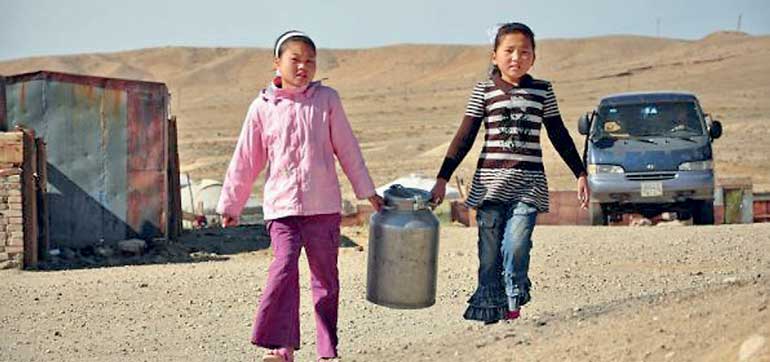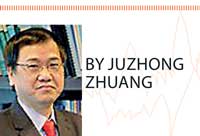21 Jun 2017 - {{hitsCtrl.values.hits}}

 The news on inequality is both good and bad. While the global income disparity has narrowed significantly over recent decades thanks to robust economic growth in many low- and middle-income economies, gaps within countries have widened significantly.
The news on inequality is both good and bad. While the global income disparity has narrowed significantly over recent decades thanks to robust economic growth in many low- and middle-income economies, gaps within countries have widened significantly.
In developed countries, the average income share of the richest 10 percent of the population has increased to 35 percent today from 29 percent in the 1980s. In a large part of developing Asia, including the People’s Republic of China (PRC), India and Indonesia, the region’s three most populous economies, inequality has worsened since the 1990s, according to the Asian Development bank (ADB) data.
Reducing inequality is a key priority for governments. If left unfettered, it can dampen the poverty-reducing impact of economic growth and even undermine growth itself. Indeed, if inequality had remained stable in Asia, economic growth between 1990 and 2013 would have lifted an additional 165 million people out of extreme poverty. In the Organisation for Economic Co-operation and Development (OECD) countries, rising inequality is estimated to have knocked nearly 5 percentage points off cumulative growth between 1990 and 2010.
High inequality can affect growth in several ways. It can cause misallocation of human capital, create social tensions, hollow out the middle class and damage the quality of a country’s institutions. Empirical studies link inequality to increased crime and violence, which can in turn hurt investment.
It can cause political problems too, as public pressure grows on governments to rebalance the scales. In response, politicians may favour populist policies that benefit low-income groups over the short term, but which in the long run can hold back efficiency and growth.
Recent policy discussions have focused on technological change, globalization and market deregulation as key contributing factors to rising inequality worldwide. These forces have been primary drivers of global economic growth in recent decades but this has not benefited everyone equally.
Divisive factors
Growth has favoured skilled over less-skilled workers, and gains have been skewed to favour capital over labour and certain geographical locations over others.
Technological change can increase the productivity of skilled workers faster than that of manual workers, thereby reducing the demand for the latter while increasing wage differentials and skewing incomes. It can also reduce demand for labour overall, pushing down real wages relative to returns on capital such as machinery, computers and software and reducing the share of national income going to labour.
Globalization and trade integration can alter demand for skilled and manual workers and change wage differentials. Financial integration can expand access to finance for the poor, but increase exposure to global financial market volatility, which often hurts the poor more than the rich. Further, those with higher incomes and assets often have disproportionately wider access to financial products and services.
Market deregulation can support economic growth but also widen income gaps. Labor market reforms may reduce the influence of trade unions or soften employment protection, thereby weakening the bargaining position of workers.
The impact of the drivers of growth can be geographically uneven and lead to spatial inequality. Essentially, where you live often determines your access to opportunity and therefore income. This is because new economic opportunities often gravitate to locations closer to existing trade routes, particularly coastal areas, and to places with better public infrastructure, usually cities.
Numerous studies offer empirical evidence showing how income distribution is affected by a person’s relative access to skills and capital as well as by where they live. In many Asian countries, the amount of inequality due to differences in educational attainment increased significantly during the 1990s and 2000s. In the PRC, it increased from less than 10 percent to more than 25 percent, from 20 percent to 30 percent in India and from 30 percent to 35 percent in the Philippines. During the same period, the share of labour income out of value added in manufacturing declined in the PRC, India, Indonesia, Singapore and the Republic of Korea.
In developing Asia, spatial inequality, as manifested in gaps between different areas, particularly urban versus rural districts, has been a key driver of rising income inequality. In the PRC, spatial inequality accounted for more than 50 percent of total income inequality in 2007, though recent data suggest that regional disparities and urban-rural income gaps have begun to decline.
Poor governance and weak institutions can compound the problem. They allow certain individuals and groups to gain disproportionately from technological progress, globalization and market deregulation.
Tackling gaps
Policy measures should not aim to stop or stem globalization, slow technological progress or reverse necessary market deregulation, as these underpin economic growth.
There is no blanket solution to inequality. Policies should be developed to address the underlying drivers, which vary from country to country.
Greater investment in education and skills training, especially for low-income and marginalized groups, can soften the blow of job losses caused by technological progress and globalization. By strengthening social protection and safety nets, countries can prevent less-skilled people from falling too far behind.
If inequality stems from labour receiving a declining share of national income, an effective response would be to adopt policies that support job creation and increase demand for labour. These could include supporting the development of small- and medium-sized enterprises, removing market distortions that favour the use of capital over labour and providing the necessary employment protections, including a minimum wage, that do not impose excessive costs on business.
In cases where financial deepening causes inequality, policies to promote financial inclusion can help reverse the trend. Effective regulation and supervision of the financial sector can prevent financial crises and extraction of rents gained through monopolistic practices or excessive remuneration.
Reducing disparities between urban and rural areas is particularly important for developing countries. Accomplishing this requires infrastructure investment to improve regional connectivity, reforms to remove barriers to migration such as those stemming from the PRC’s household registration system and urban development so cities can absorb migrants.
Poor governance and institutions can be addressed through measures such as more effective enforcement of anti-corruption legislation and competition policy. It is encouraging to see that many countries in developing Asia have stepped up anti-corruption efforts in recent years.
In many Asian countries, the tax system plays a limited role in income redistribution. Tax reforms should be a priority in efforts to reduce inequality. In the PRC, where overall income inequality has declined from its recent peak but remains high, the government has recognized the need to reform the personal income tax.
Options for Asian countries include introducing taxes that are inherently progressive such as on capital gains, property and inheritance levies. At the same time, more can be done in reorienting spending from inefficient general subsidies, such as those for fuel, to targeted transfers.
Rising inequality is a complex challenge. The solution is to introduce policies that do not slow down economic growth but spread its benefits more equitably.
(Juzhong Zhuang is Deputy Chief Economist and Deputy Director General, Economic Research and Regional Cooperation, Asian
Development Bank)
07 Jan 2025 7 hours ago
07 Jan 2025 7 hours ago
07 Jan 2025 8 hours ago
07 Jan 2025 07 Jan 2025
07 Jan 2025 07 Jan 2025